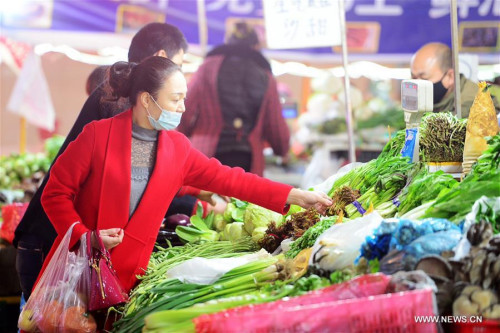
Residents purchase vegetables at a supermarket in Shijiazhuang, capital of north China's Hebei Province, March 9, 2016. (Xinhua/Zhu Xudong)
China's consumer prices increased 2.3 percent in February from one year earlier, up from January's 1.8 percent, official data showed Thursday.
The inflation rate, the highest since July 2014, beat expectations as economists from the Bank of Communications, and China Merchants Bank had forecast an increase of 1.8-percent year on year for February.
Consumer price index (CPI), the main gauge of inflation, grew 1.6 percent month on month, the National Bureau of Statistics (NBS) said in a statement.
HSBC analyst Qu Hongbin attributed the higher-than-expected CPI growth largely to food-price inflation.
Food prices, which account for one-third of the CPI calculation, soared 7.3 percent year on year while non-food inflation edged up 1 percent.
Pork prices jumped sharply by 25.4 percent year on year, contributing 0.59 percentage points to CPI growth, while vegetable prices skyrocketed by 30.6 percent, or 0.86 percentage points to CPI growth.
NBS statistician Yu Qiumei said that vegetable and pork prices went up due to the cold weather in February, and demand for pork and transportation rose around the Lunar New Year holiday. Service prices increased along with labor costs.
Higher service prices, including tourism and household services, pushed up non-food inflation, according to a research note from the China International Capital Corporation Limited (CICC).
Since this January, CPI data has been based on a new comparison base that takes into account new products and services, reflecting a change in the consumption pattern, according to NBS. The adjustment slightly tuned down the weight of food.
China's producer price index (PPI), which measures wholesale inflation, dropped for the 48th-consecutive month to 4.9 percent year on year in February, narrowing from the 5.3-percent drop in January and 5.9-percent in December.
Qu attributed the easing contraction to stabilizing commodity prices during the period.
Month on month, producer prices in February edged down 0.3 percent.
The PPI and CPI are related, as the PPI reflects prices in production, while the CPI reflects prices at the point of consumption. Price fluctuations usually first appear in the production phase before being passed on to consumers.
The rising CPI signaled easing of deflationary pressure, but analysts are still concerned.
"The rise in inflation was mostly caused by temporary factors and is not expected to last," said Zhao Qingming, chief economist at the Institute for Financial Derivatives, an research arm of China Financial Futures Exchange.
Qu further pointed out that downward pressure on non-food prices still looms large.
"The deflationary risks see no significant easing," he noted.
According to a government work report delivered by Premier Li Keqiang at the annual legislative session last week, China aims to hold this year's consumer price growth at around 3 percent. The target is unchanged from that for 2015, but the consumer price index only rose 1.4 percent last year, a six-year low.
The CICC expected China's fiscal policy and monetary policy will remain loose in 2016, as the government raised its budget deficit ratio to 3 percent from 2015's 2.3 percent.
"Looking forward, deflationary pressure will likely ease gradually and inflation this year may be higher than last year," according to the CICC, forecasting that CPI growth will stay above 2 percent year on year in the short term.
Read more:
China producer prices down 4.9 pct in February
China's producer price index (PPI), which measures costs for goods at the factory gate, slid 4.9 percent year on year in February, official statistics showed on Thursday.


















































